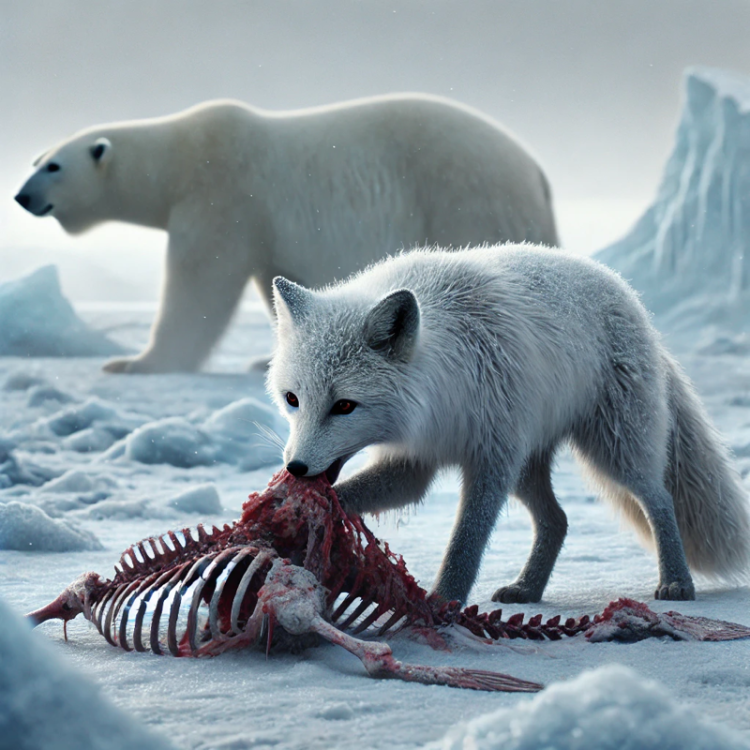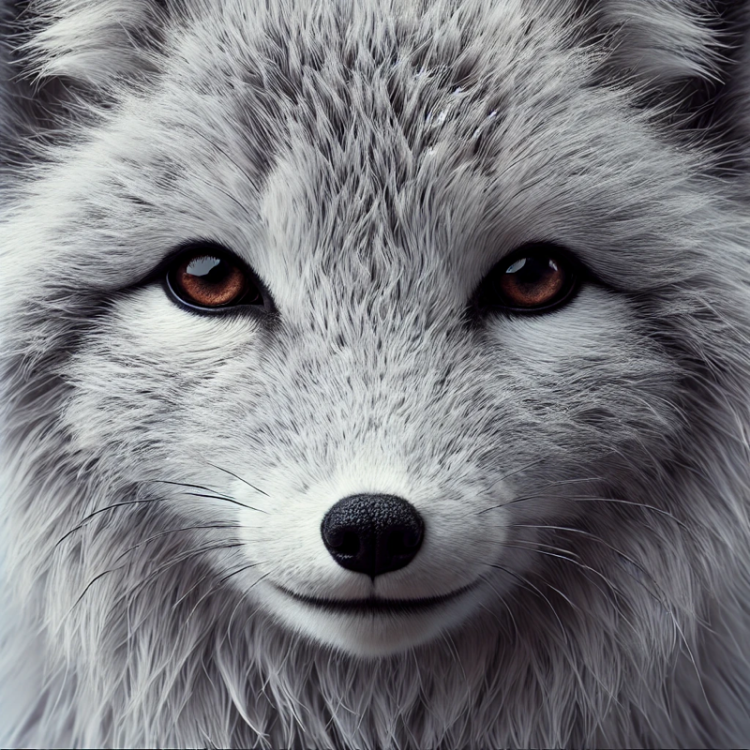The Arctic Fox: Survival, Camouflage, Danger, and Struggle
The Arctic fox (Vulpes lagopus) is one of nature’s most fascinating creatures, perfectly designed to survive in the harshest conditions on Earth. From its incredible camouflage to its tough survival instincts, this small but mighty fox thrives where few animals can. However, life in the Arctic is anything but easy—between predators, changing climates, and food shortages, the Arctic fox is constantly facing danger and struggle. Let’s take a closer look at how this amazing animal survives in the frozen north.
A Master of Survival
The Arctic fox is built to withstand extreme cold. Thanks to its thick fur, the Arctic fox can survive temperatures as low as -50°C (-58°F)—its fur is even warmer than that of a polar bear's! It also has a compact body, small ears, and a bushy tail that help conserve heat in freezing conditions.
Food is often scarce in the Arctic, so the fox uses clever ways to find meals. It hunts small animals like lemmings, birds, and fish, and when food is especially hard to come by, it will scavenge leftovers from polar bears or even bury food to eat later. Arctic foxes have an incredible sense of hearing, allowing them to listen for small animals beneath the snow. Like other species of fox, when it detects movement, it leaps high into the air and dives straight into the snow, an action called “mousing.”
Like other species of fox, when it detects movement, it leaps high into the air and dives straight into the snow, an action called “mousing.”
But perhaps the most impressive survival skill of the Arctic fox is its ability to travel long distances. Scientists tracked one Arctic fox that traveled over 3,500 km (2,200 miles) from Norway to Canada in just a few months! This shows how adaptable and resourceful these animals are when searching for food and shelter.
The Arctic Fox’s Amazing Camouflage
One of the Arctic fox’s greatest defenses is its ability to blend into its surroundings. Unlike most animals, its fur changes color with the seasons.
-
Winter Coat: Pure white fur allows it to disappear into the snowy Arctic landscape, helping it avoid predators and sneak up on prey.
-
Summer Coat: As the snow melts, the fox’s fur turns brown or gray, matching the tundra’s rocks and vegetation.
This color change is more than just for looks—it’s a matter of life and death. Without it, the fox would be an easy target for predators like wolves, golden eagles, and polar bears.
Interestingly, not all Arctic foxes turn white. Some have a rare “blue phase” where their fur stays dark gray all year long. These foxes are more common in coastal areas where dark rocks are present year-round.
The Dangers Arctic Foxes Face
Survival in the Arctic is challenging, but natural predators aren’t the only threat these foxes face.
-
Climate Change – Rising temperatures are melting the ice and reducing the fox’s habitat. As the tundra warms, other animals, like the red fox, are moving north and outcompeting Arctic foxes for food.
-
Food Shortages – Arctic fox populations depend heavily on lemmings, which have population booms and crashes. When lemmings are scarce, Arctic fox numbers drop.
-
Hunting and Fur Trade – The Arctic fox has been hunted for its luxurious fur, though protections are in place in many regions.
In some places, especially in Scandinavia, Arctic foxes are critically endangered. Conservation programs in Norway and Sweden are working to help them by reintroducing foxes and protecting lemming populations.
The Arctic Fox’s Role in the Food Chain
The Arctic fox is both a hunter and hunted. It keeps rodent populations in check and helps recycle nutrients by scavenging carrion. However, it must always stay alert because larger predators—wolves, wolverines, and even snowy owls—are constantly watching for an easy meal.
Despite these challenges, the Arctic fox remains one of the toughest survivors in the animal kingdom.
Jehovah’s Incredible Design in the Arctic Fox
Looking at the Arctic fox, we see an animal perfectly suited for its environment, a clear reflection of Jehovah’s wisdom. Its changing fur, expert hunting skills, and resilience in freezing temperatures demonstrate divine design, equipping it with everything needed to survive in the Arctic. In the same way, He provides us with His Holy Spirit, which strengthens and guides us through life's challenges.
As humans, we also face challenges, struggles, and dangers in life. But just as Jehovah provided everything the Arctic fox needs to thrive in the Arctic, He also provides us with strength, wisdom, and guidance through His Holy Spirit, helping us endure trials and make wise decisions. This reminds us of Isaiah 41:10, where Jehovah says:
"Do not be afraid, for I am with you. Do not be anxious, for I am your God. I will fortify you, yes, I will help you. I will really hold on to you with my right hand of righteousness."
Like the Arctic fox, we can trust in Jehovah’s design and care, knowing that He has provided everything we need to survive—even in the harshest of life’s challenges. His Holy Spirit acts as a helper, equipping us with endurance, peace, and discernment to navigate our way successfully.
Sources & Fact-Checking
Scientific Papers:
Zimova, M., Moberg, D., Mills, L. S., Dietz, A., & Angerbjörn, A. (2022). Colour moult phenology and camouflage mismatch in polymorphic populations of Arctic foxes. Biology Letters, 18.
Laporte‐Devylder, L., Ulvund, K., Rød‐Eriksen, L., Olsson, O., Flagstad, Ø., Landa, A., Eide, N., & Jackson, C. (2022). A camera trap‐based assessment of climate‐driven phenotypic plasticity of seasonal moulting in an endangered carnivore. Remote Sensing in Ecology and Conservation, 9.
Xu, Z. (2023). Effect of Climate Change on Arctic Fox (Vulpes/Alopex Lagopus). Highlights in Science, Engineering and Technology.
Fuglei, E., & Ims, R. (2008). Global Warming and Effects on the Arctic Fox. Science Progress, 91, 175-191.
Dudenhoeffer, M., Roth, J., Johnson, L., & Petersen, S. (2021). Arctic fox winter dietary response to damped lemming cycles estimated from fecal DNA. Journal of Mammalogy, 102, 1455-1465.
Gilg, O., Sittler, B., & Hanski, I. (2009). Climate change and cyclic predator–prey population dynamics in the high Arctic. Global Change Biology, 15.
Cockerill, C. A., Hasselgren, M., Dussex, N., et al. (2022). Genomic Consequences of Fragmentation in the Endangered Fennoscandian Arctic Fox (Vulpes lagopus). Genes, 13.
Additional Research Sources:
-
IUCN Red List of Threatened Species – Arctic Fox Conservation Status
-
National Geographic – Arctic Fox Adaptations and Behavior
-
WWF (World Wildlife Fund) – The Impact of Climate Change on Arctic Foxes
-
The Arctic Report Card (NOAA) – How Climate Change is Affecting Arctic Wildlife
Edited by dljbsp
- Roxessence and Tortuga
-
 1
1
-
 1
1


0 Comments
Recommended Comments
There are no comments to display.
Join the conversation with your brothers and sisters!
You are posting as a guest. If you are already a member, sign in now to post with your existing account.
Note: Your post will require moderator approval before it will be visible.